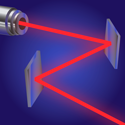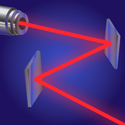The chill factor of squeezed light
Cooling a macroscopic object to its mechanical ground state would enable many high-precision measurements that are currently limited by thermal noise, as well as open the possibility to observe a macroscopic quantum superposition of quantum states.
Analogous to the laser cooling of neutral atoms, radiation pressure can cool a mechanical resonator, such as a nanoscale beam. This has become an active area of research since the first experimental demonstrations in 2006, but so far, it has not been possible to cool a resonator completely to its ground state.
In a paper appearing in Physical Review A, Sumei Huang and Girish Agarwal of Oklahoma State University propose that using a “squeezed” beam of light instead of a classical field can enhance the effectiveness of cooling a resonator with radiation pressure. In a squeezed beam, one component of the radiation field has reduced noise at the expense of enhanced noise in the other component. Huang and Agarwal show that by coupling a parametric oscillator (a source of squeezed light) to a mechanical resonator, it should be possible to reduce the temperature of the resonator by a factor up to 20 compared with using a classical field.
If this method can be experimentally demonstrated and verified, it may lead to ground-state cooling of optomechanical resonators and have applications in high-precision metrology, such as gravitational wave detection. – Frank Narducci





